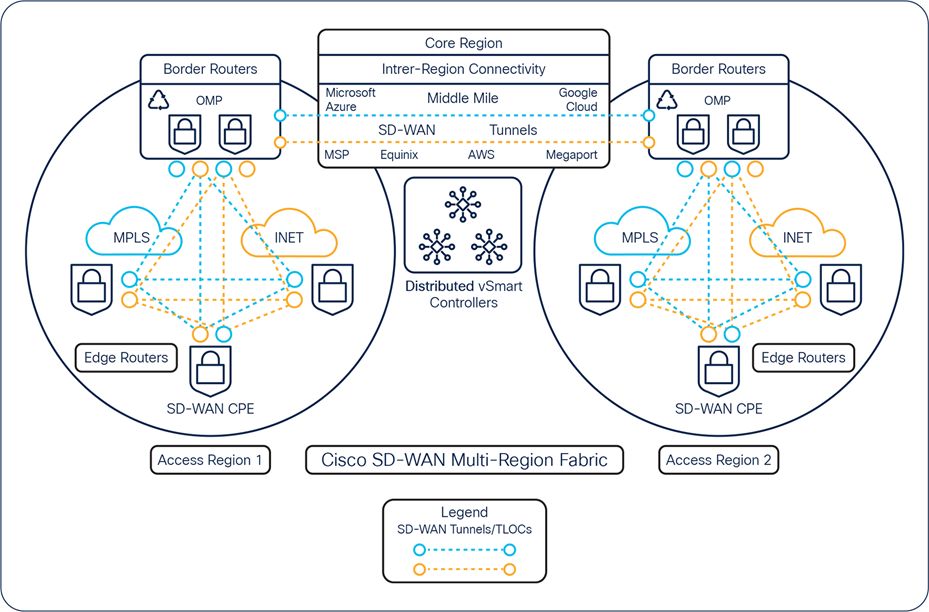Cisco SD-WAN Multi-Region Fabric
At-a-Glance
Available Languages
Bias-Free Language
The documentation set for this product strives to use bias-free language. For the purposes of this documentation set, bias-free is defined as language that does not imply discrimination based on age, disability, gender, racial identity, ethnic identity, sexual orientation, socioeconomic status, and intersectionality. Exceptions may be present in the documentation due to language that is hardcoded in the user interfaces of the product software, language used based on RFP documentation, or language that is used by a referenced third-party product. Learn more about how Cisco is using Inclusive Language.
Multicloud architectures are driving the need for networks with global connectivity
With applications and workloads moving to multicloud architectures, businesses need to ensure that their SD-WAN design and architecture can scale easily without impacting the seamless connectivity, security, and performance end users expect across the globe. To achieve network scalability, organizations are pivoting to designs that involve splitting up the network into multiple regions, with geo-specific points of presence (PoPs) or service exchanges leading to a hierarchical architecture. To benefit from a hierarchical or multiregion type of network architecture, the use of a middle-mile WAN or global backbone WAN network is becoming increasingly prevalent. In this architecture, the middle-mile or backbone WANs can be provided by:
1. Managed Service Providers for customers with managed WANs, or
2. Software-Defined Cloud Interconnect providers like Megaport and Equinix
3. Cloud Service Providers such as AWS, Azure, Google Cloud Platform
4. DIY Colocation services for Enterprise customers.
This type of network design has significant benefits for both managed service providers as well as for Enterprise customers who require higher levels of scalability and flexibility.
Adopting a multiregion network design demands resolving a few network and operational challenges. However, deploying a multi-region network doesn’t have to mean increased complexity for the IT staff. An easy approach to accomplish this is to extend the SD-WAN fabric over the middle-mile WAN as well, thus enabling the organization to use SD-WAN to manage both intra- and inter-region site-to-cloud and site-to-site traffic via a single pane of glass.
Cisco SD-WAN Multi-Region Fabric is a new suite of capabilities that divides a single Cisco SD-WAN overlay network into multiple regions with a central core-region network for managing inter-regional traffic. You can scale the network architecturally and operationally by introducing the concept of regions and device roles natively into your SD-WAN solution. It enables you to extend the Cisco SD-WAN fabric across multiple regions within your network as well as the middle mile, to provide end-to-end SD-WAN capabilities and control.
Benefits of Cisco SD-WAN Multi-Region Fabric
Cisco SD-WAN Multi-Region Fabric offers managed service providers (MSPs) and global enterprises the capabilities to enhance, scale up, and, more importantly, simplify their Cisco SD-WAN fabric across regions. Cisco SD-WAN Multi-Region Fabric helps you:
● Improve flexibility and traffic performance across regions by selecting the best transport for each region
● Simplify policy design to prevent certain traffic routing failures caused by policy
● Enforce security with end-to-end encryption of inter-region traffic
● Simplify and gain better control over traffic paths between domains
● Enable site-to-site traffic paths between disjointed providers
● Optimize tunnel encapsulation for the core region and regional networks

Cisco SD-WAN Multi-Region Fabric reduces operational complexity by introducing regions and device roles natively into Cisco SD-WAN
Scale networks and deploy global connectivity with Cisco SD-WAN Multi-Region Fabric
Cisco SD-WAN Multi-Region Fabric offers advanced capabilities such as region-aware routing and simplified site scalability for higher throughput, as well as reducing the complexity of network architecture and policy configuration. It provides the ability to enforce a common traffic steering policy across the entire WAN or by region and to deploy end-to-end WAN segmentation – all via a single dashboard (vManage) to configure, monitor, and troubleshoot the network. This new capability within the SD-WAN fabric allows the creation of a globally distributed network in minutes with just a couple of clicks.
Multi-Region Fabric delivers reduced complexity, increased scalability, and greater performance
This new architecture can provide significant benefits for customers, partners, and MSPs who are considering the adoption of a hierarchical network design (with a middle mile) for use cases such as:
● Regionalization of network services such as security, identity management, NetFlow, logging, WAN optimization, etc.
● Improving multicloud and software-as-a-service (SaaS) user experience by providing high-quality onramps into SaaS and cloud infrastructure providers such as Amazon Web Services, Microsoft Azure, and Google Cloud Platform via regional PoPs.
● Reducing time spent on the last mile for user traffic.
● Adapting network scale, compliance, or resiliency in a geo/segment/region-specific manner.
Are you looking to increase the scalability of your SD-WAN fabric design for global connectivity, simplify network operations, accelerate multicloud adoption, or do anything that involves a middle mile? Get the scalability your network needs with Multi-Region Fabric capabilities within Cisco SD-WAN.
Cisco SD-WAN Multi-Region Fabric video